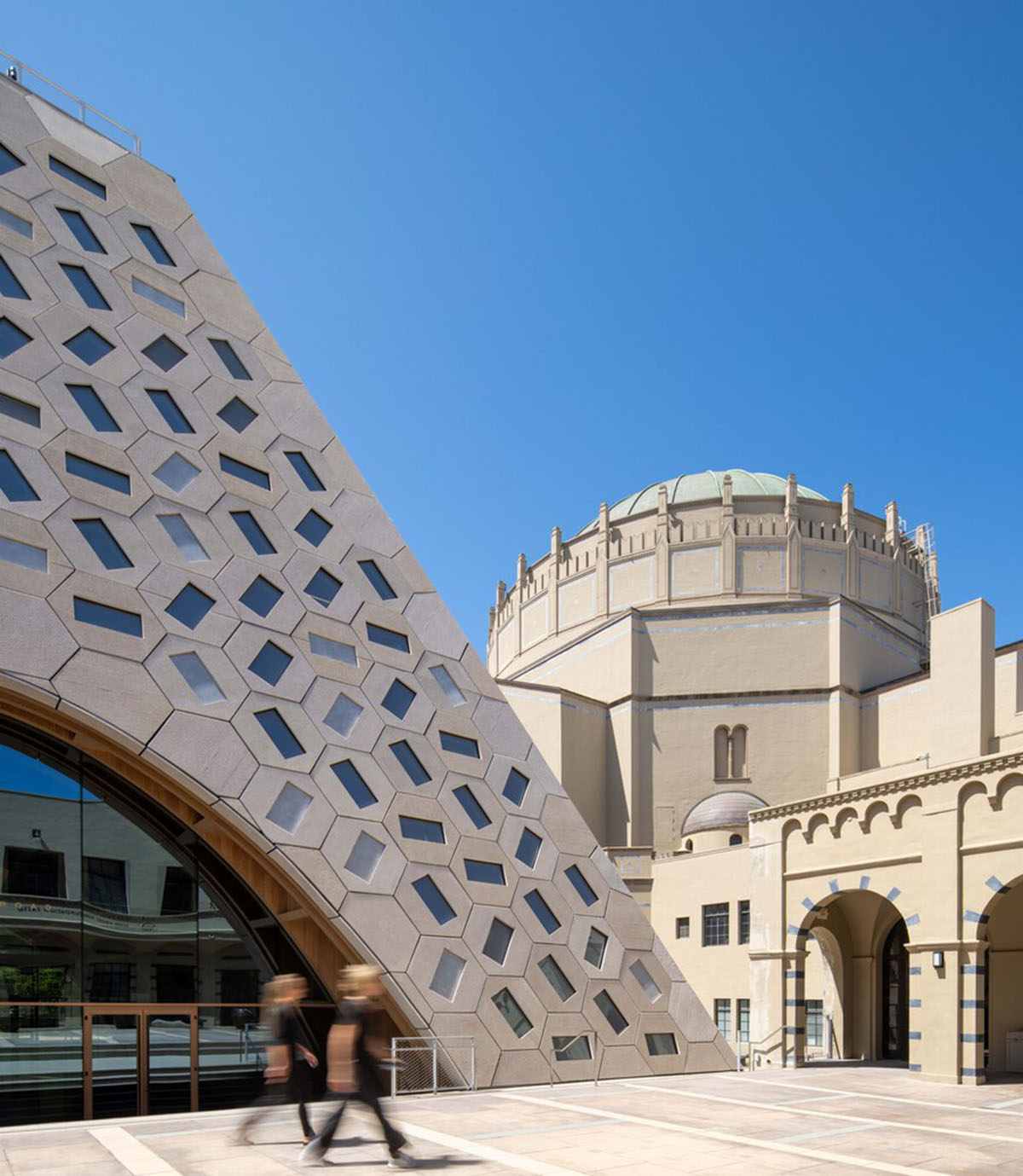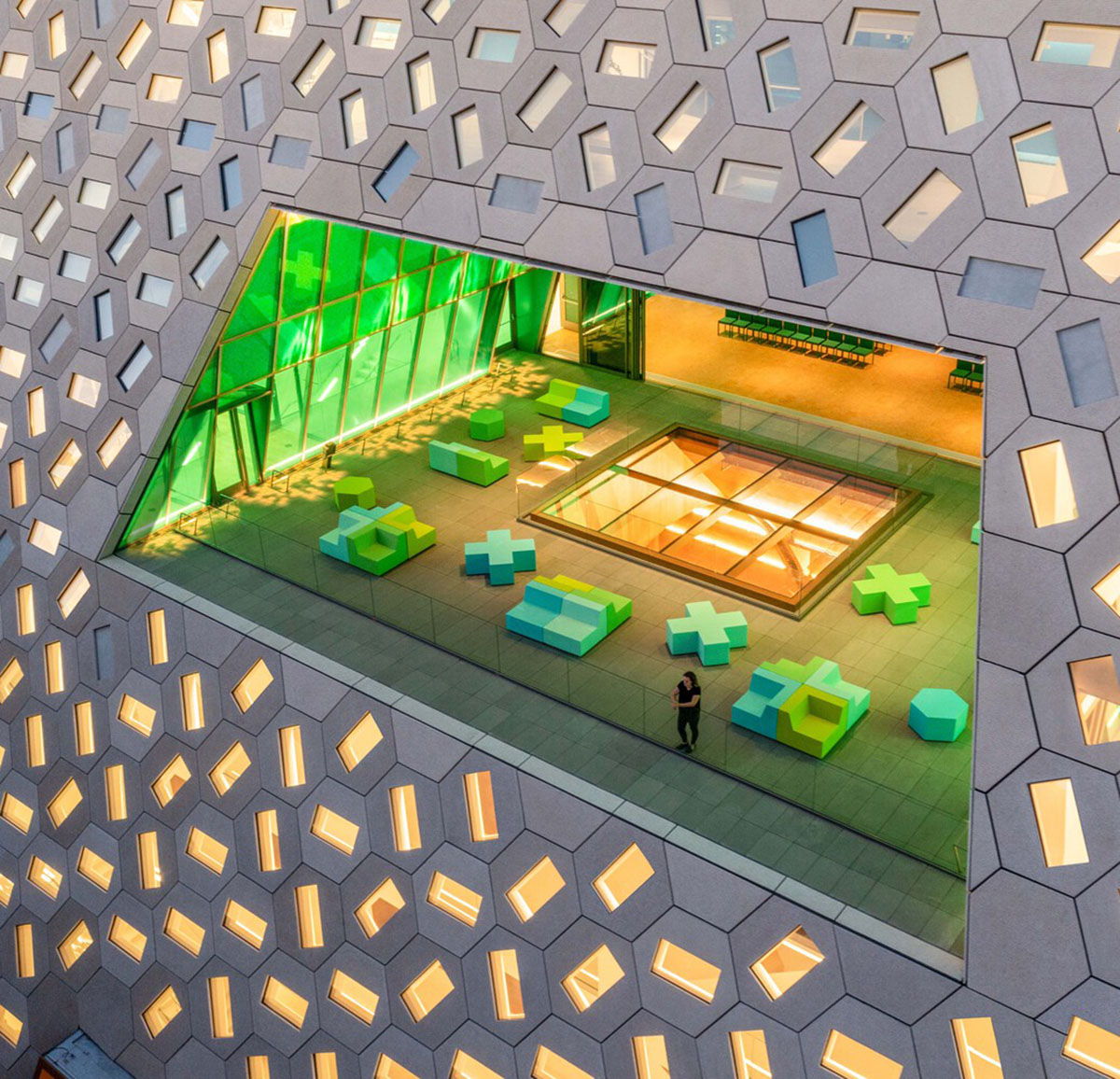Submitted by WA Contents
OMA completes Audrey Irmas Pavilion with trapezoidal form that respects its surrounding in California
United States Architecture News - Sep 06, 2021 - 09:23 4502 views

Global architecture firm OMA has completed the Audrey Irmas Pavilion at Wilshire Boulevard Temple in Los Angeles, California, which is the project is OMA New York’s first commission from a religious institution and first cultural building in California.
The 55,000-square-foot (5,070-square-metre) Audrey Irmas Pavilion is made of hexagonal stone tiles and presents a strong volumetric character that respects its own surrounding with its trapezoidal shape.
The design, led by OMA New York Partner Shohei Shigematsu and situated in the heart of Koreatown/Wilshire Center, was conceived as "a response to the Wilshire Boulevard Temple’s vision for its campus to create a much-needed space to convene."

In the west, the three-story building slopes away from the existing historic temple, which was completed in 1929, to create a thoughtful buffer and framing a new courtyard between the two buildings. The Pavilion leans south, away from the historic school, opening an existing courtyard to the sky to bring light in.
The pavilion houses multi-functional spaces for its community, such as main event space, spaces for banquets, markets, conventions, performances, and art events.

Although the pavilion has been completed, it is expected to open in January 2022. In 2015, OMA was selected from a competitive field to design the building and construction for the project started in 2018.

"The making of the Audrey Irmas Pavilion sustained forward momentum through the COVID-19 Pandemic, a period in which the act of human interaction was questioned and contemplated," said Shohei Shigematsu, OMA Partner-in-Charge.
"Its completion comes at a time where we hope to come together again, and this building can be a platform to reinstate the importance of gathering, exchange, and communal spirit," Shigematsu added.

In 2015, OMA was selected from a competitive field to design the building. Conceived to be a platform for gathering, the pavilion was aimed to forge new connections with the existing campus activities while inviting the urban realm in to create a new civic anchor.
"The Pavilion aims to harness the energy of gathering by simultaneously respecting historic traditions and reflecting modern civic needs," OMA said.

"The making of the Audrey Irmas Pavilion sustained forward momentum through the COVID-19 Pandemic, a period in which the act of human interaction was questioned and contemplated," said Shohei Shigematsu, OMA Partner-in-Charge.
Its completion comes at a time where we hope to come together again, and this building can be a platform to reinstate the importance of gathering, exchange, and communal spirit," Shigematsu added.

Rabbi Steve Leder stated that "We are thrilled to see the completion of the Audrey Irmas Pavilion and with that, the completion of the Building Lives Campaign that included the plan to restore of our historic sanctuary, create state-of-the-art early childhood and elementary school buildings and programs, a sports complex, a social services center to help our needy neighbors with food security, dental and vision care, legal aid and mental health services in Korean, Spanish and English at no cost to them, parking, robust security for all, and finally the Audrey Irmas Pavilion."
"With this modern masterpiece, the Temple brings another stunning, radiant landmark to our community and the entire city of Los Angeles. The Pavilion further expresses our role as a steadfast institution of learning, gathering, and giving. It is amazing to see this come to fruition after so many years and to add the final, breathtaking building to our urban campus," Leder added.

OMA followed a contextual approach on the project to be as simple as possible. As OMA states, "the starting point was a box: the all-too generic model for an event space. The basic box is shaped with forms out of respect to the adjacent historical buildings on the campus."

Creating a parallelogram, it simultaneously reaches out toward the main urban corridor, Wilshire Boulevard, to establish a new urban presence.
OMA creates an ultimate form and carves the building by considering its relationship to its neighbors. While the pavilion is both enigmatic and familiar, the building forms a counterpoint to the Temple that is at once deferential and forward-looking.

"Event spaces often sacrifice character for flexibility," according to OMA. In this building, OMA provides flexibility through diversity in scale and spatial characters for gathering.

Consists of three distinct gathering spaces, these spaces are expressed as voids punctured through the building - a main event space is represented with a large void, a chapel and terrace are represented with medium openings, and a sunken garden is represented with small opening.

The three spaces are interlocked and stacked one atop another to establish vantage points in and out of each space. Within each space are a series of openings that filter light and frame views to the Temple and historic school, reorienting visitors to the complex and beyond.

"We assembled a constellation of spaces, distinct in form, scale, and aura—an extruded vault enveloped in wood establishes a multi-functional, central gathering space and connective spine; a trapezoidal void draws tones from the Temple dome and frames its arched, stained-glass windows; and a circular sunken garden provides an oasis and passage to a roof terrace overlooking LA," added Shohei Shigematsu.
"Three interconnected voids make the solid form of the Pavilion strategically yet surprisingly porous, engaging the campus and the city. The Pavilion will support both old and new activities, values, and traditions to foster a renewed energy for gathering."

The main event space is placed at the ground level and evokes the Temple dome by lowering the arc and extruding it north across the site to connect Wilshire Boulevard to the school courtyard.

In its full length, the building features a high-vaulted, column-free space, made of deep timber sections, and allows a huge capacity to host diverse programs such as banquets, markets, conventions, performances, and art events. There is an oculus providing a view through the void above to the dome of the historic Temple.

On the second level, a more intimate chapel and outdoor terrace are placed. While the trapezoidal room and terrace face west, they also frame the arched stained-glass windows of the historic Temple.
On the other hand, a third void represents a sunken garden that connects smaller meeting rooms on the third floor to the rooftop event space with expansive views of Los Angeles, the Hollywood sign, and the mountains to the north.

Together, the voids establish a diverse collection of spaces for multiple purposes—from sermons and studies, to b’nai and b’not mitzvah and concerts, to work and relaxation.

"As the ideal host for the Wilshire Boulevard Temple community, the Audrey Irmas Pavilion provides gathering spaces that can engage both internally and externally. In relationship to its classical counterpart, the pavilion offers a dynamic dialogue, politely reclining from the Temple and leaning towards Wilshire Blvd to invite visitors in," said Jake Forster, OMA Associate.
"A complex of interior and exterior spaces distributed over multiple levels connect campus to city and frame new perspectives of the existing temple."
"After six years of collaborating with the Temple, the design team is so proud to deliver a nimble infrastructure ready to meet the diverse community’s needs - spiritual and municipal, reflective and communal, flexible but unique," Forster added.

The Audrey Irmas Pavilion's façade is drawn to create a specific character derived from the geometries of the Temple’s dome interior. OMA used a single hexagon unit with a rectangular window that is rotated to reflect the program within and aggregated to create a distinct pattern.

The firm used 1,230 hexagonal glass fibre reinforced concrete (GRFC) panels to enhance the building’s volumetric character to add a human-scaled texture that reduces the weight of the mass.

As OMA highlighted, "the tonality and materiality resonate with the textures of the existing Temple and campus while enhancing interior moments of color throughout the Pavilion."
"The seemingly neutral color of the façade is enhanced by its texture, changing in tone depending on the time of day and the orientation of individual panels’ ridges."

OMA founder Rem Koolhaas was also commissioned to design a mezuzah for each door frame within the Pavilion. "The purpose of the mezuzah is to act as a constant reminder of God's presence, identifying Jewish homes as places of kindness, The Torah, generosity and peace," OMA stated.
For their design, each individual letter atop each mezuzah called a shin, was meticulously developed, hand-cut, filed and polished before being adhered to the mezuzah crafted from aluminum foam and cast in colored resin.

"I was both intrigued and challenged to design the mezuzahs for the doors within the Pavilion," said Rem Koolhaas.
"It is an unexpected religious object having to answer explicit religious edicts, laws and rules which made it totally fascinating for me and a very good lesson to have at some point in my life," Koolhaas added.











The Audrey Irmas Pavilion was designed by Partner Shohei Shigematsu of OMA New York with Associate Jake Forster and Architect Jesse Catalano of the design team.
OMA recently revealed images for high-end office building in Amsterdam which is led by OMA Managing Partner David Gianotten. OMA is currently designing the first American Centre Pompidou Outpost Iin Jersey City.
Project facts
Partner-in-charge: Shohei Shigematsu
Associate-in-charge: Jake Forster
Team: Jesse Catalano, David Chacon, Caroline Corbett, Nils Sanderson, Andrea Zalewski, Natasha Trice, Marie Claude Fares, Wesley LeForce, Sandy Yum, Jade Kwong, Shary Tawil, Joanne Chen
Executive architect: Gruen Associates
Structure, MEP, facades, FLS, communications: Arup
Performance space consultants: TheatreDNA
Landscape: Studio-MLA
Lighting: L'Observatoire International
Signage/graphic design: Space Agency
Civil engineer: Rhyton Engineering
Vertical transportation: Syska Hennessy Group
General contractor: MATT Construction
All images © Jason O'Rear.
> via OMA
